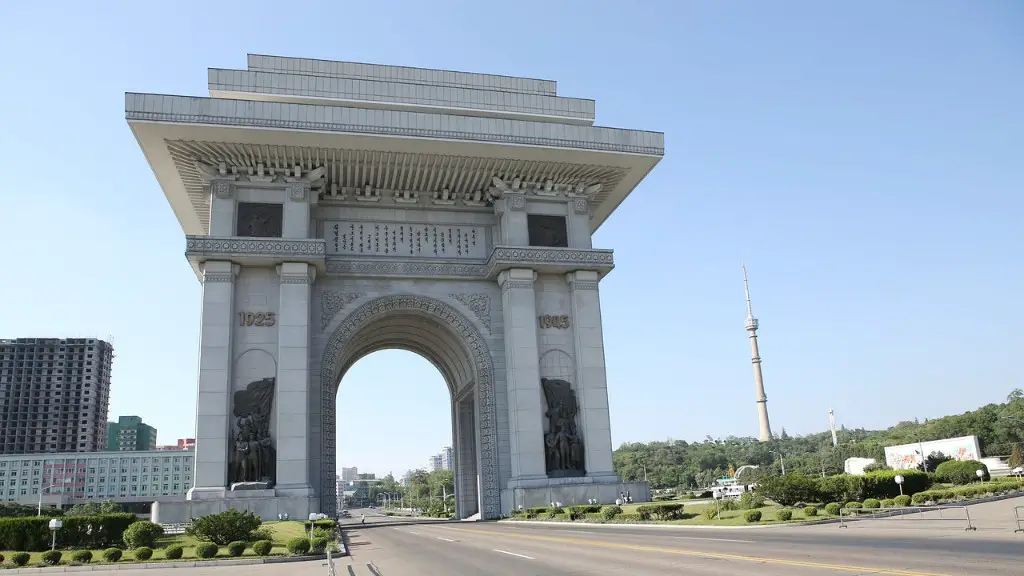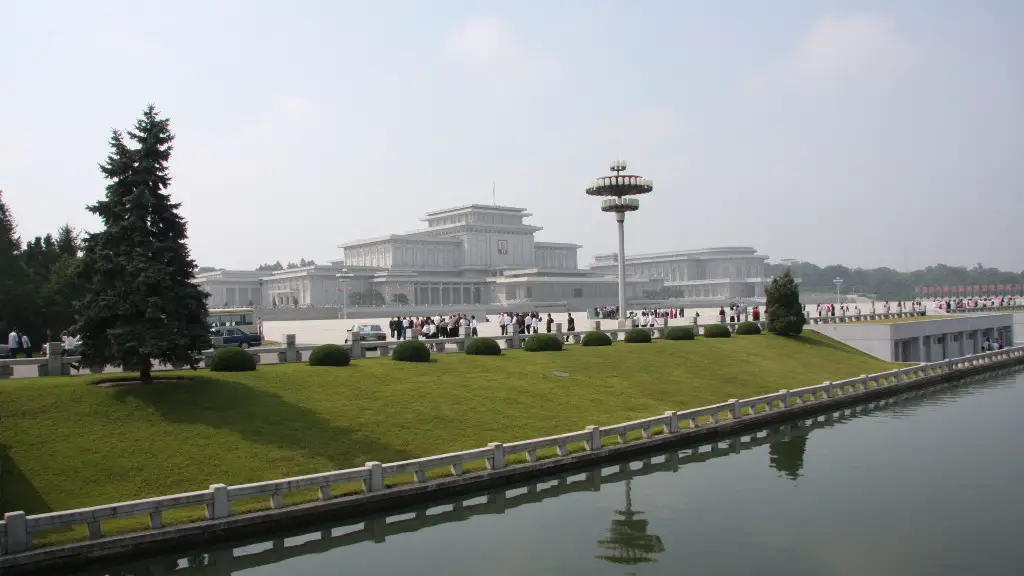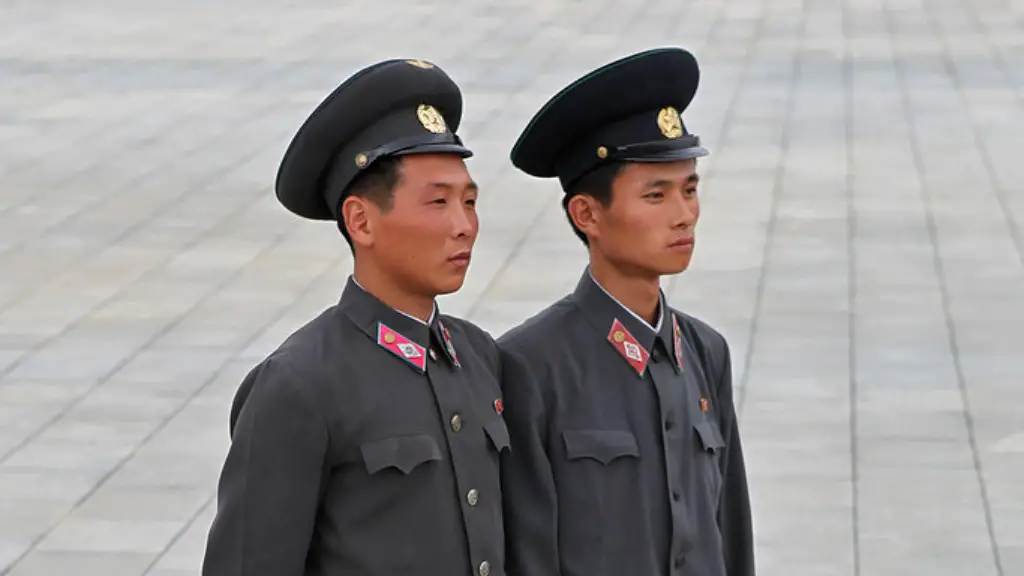Background of the Conflict
The invasion of South Korea by North Korea in 1950 that sparked the Korean War was a direct result of the Cold War policies of the Soviet Union and the United States. Prior to the conflict, Korea had been unified for centuries under the rule of the Korean Empire. In 1945, the United States and the Soviet Union agreed to partition the country at the 38th parallel as a part of the Potsdam Agreement, in which the United States administered the southern part of the peninsula while the Soviet Union administrated the northern region. This agreement effectively split the country in two and gave rise to the two separate nations of North and South Korea.
In 1948, elections were held in the south and Rhee Syngman of the right-wing Liberal Party was declared president of the Republic of Korea (South Korea) by the US-backed United Nations Temporary Commission. In the north, Kim Il-sung took power and led the Communist Democratic Peoples Republic of Korea (North Korea), with the backing of the Soviet Union. Tension between the two countries began to mount, as each nation sought to lengthen their sphere of influence over their respective halves of the country.
Reasons for the Invasion
The immediate cause for North Korea’s invasion of the South was a desire for unifying the two countries under a communist rule. Kim Il-sung had long sought to make Korea a unified communist state, and as South Korea was seen as a threat to this, he decided to take action. He had the full support and backing of the Soviet Union, who saw North Korea’s move as an opportunity for them to spread communism in East Asia. North Korea also had a military advantage, having trained more men and built more tanks than the South, due to the Soviets supplying the former with weapons.
The South was also seen as more open to US intervention, as the south had agreed to hold free elections and the US had agreed to supply military aid. This was seen as a threat to North Korea and its communist regime and as such Kim Il-sung moved to take action. In late June 1950, North Korean forces began to march south, crossing the 38th parallel.
Impact of the Invasion
The invasion of South Korea in June 1950 had a profound impact on the course of the Korean War and the course of history in East Asia for the next two decades. The North Korean army, equipped with the latest Soviet weaponry and trained by experienced Soviet advisors, quickly swept across the 38th parallel. South Korea was unable to withstand the invasion and only a few days after the first onslaught, the North had captured the important cities of Seoul and Incheon.
The invasion also had a global effect as it caused a deep rift between the United States and the Soviet Union, who had been allies since the end of World War II. In response, the United Nations Security Council called for the North to withdraw and for the conflict to be resolved through diplomatic means. In the face of North Korea’s refusal to comply, the United States and its allies authorized the use of military force to repel the invasion. This marked the first time the UN had authorized collective security against aggression.
The Korean War
The Korean War lasted from June 1950 until July 1953 and is often referred to as the “Forgotten War”. During the war, North and South Korea fought fiercely against one another, and the United States, China and the Soviet Union sent troops and supplies to support their respective sides. Over the course of the three-year conflict, the two sides were essentially locked in a stalemate, unable to make major advances or gains.
At the war’s conclusion, the two sides had suffered staggering losses, with an estimated three million dead, wounded or missing. In addition, the war had caused an immense amount of destruction to both North and South Korea. The two sides reached an armistice in July 1953, but never officially signed a peace treaty and the two countries remain technically at war to this day.
Analysis of the Conflict
The conflict between North and South Korea has been a long-standing and complex problem. Although there have been periods of relative peace, the two Koreas have remained hostile towards each other since the war. In recent years, however, there have been some attempts at reconciliation between the two sides, such as the summit between North Korean leader Kim Jong-Un and the South’s President Moon Jae-in in April 2018.
The Korean War has set the stage for a wide-ranging Cold War between the United States, its allies and its former foe the Soviet Union. The conflict also highlighted the global risks posed by nuclear weapons, as the United States and the Soviet Union both deployed such arms in Korea. For many, the Korean War serves as a reminder of the devastating consequences of war, and its legacy can still be felt in the region.
Political Consequences
The Korean War had a profound impact on the political landscape of East Asia and the world. North Korea became increasingly isolated after the war due to their Communist ideals, and tensions between the countries have remained high. South Korea, meanwhile, established itself as a democracy, and is now a key US ally in the region.
The Korean War also had far-reaching effects on the Cold War. The conflict highlighted the dangers of a confrontational foreign policy, as well as the potential for a global conflict should tensions between the United States and the Soviet Union continue. The war marked a turning point for the two superpowers, as it was the first time that direct military intervention was authorized by the United Nations.
Social Consequences
The Korean War left a lasting impression on the people of both North and South Korea. The war caused untold suffering for millions of Koreans, with an estimated three million killed, injured or missing. The war also caused massive destruction to much of the country, with cities and towns razed to the ground.
The aftermath of the war also led to deep divisions between the two Koreas. In the north, citizens have lived in a society closed off to the rest of the world, with restricted access to information and no economic opportunities. In the south, citizens have enjoyed greater opportunities and are part of an increasingly dynamic and globalized region.
Media Representations of the War
The Korean War has been often depicted in popular media and is often seen as a symbol of the horror and destruction of war. In recent years, the war has been depicted in popular films such as The Ballad of Banging Rock and Operation Chromite.
The war has also been addressed in other forms of media such as books and television shows, with the Netflix series The Great Battle being one example. The war has been a source of inspiration for many musicians and songwriters, with Bruce Springsteen’s Born in the U.S.A. being the most well known.
Legacy of the War
Today, the legacy of the Korean War can still be seen in the region. North and South Korea remain technically at war, with no lasting peace treaty being signed. The two countries have nonetheless made some progress towards reconciliation in recent years, and there are hopes that a lasting peace will soon be achieved.
The war also highlights the importance of preventing conflict through international cooperation and understanding, as well as the importance of diplomacy and collective security in resolving disputes. The Korean War serves as a warning about the devastating consequences of war and a reminder of the power and potential of peaceful dialogue.


